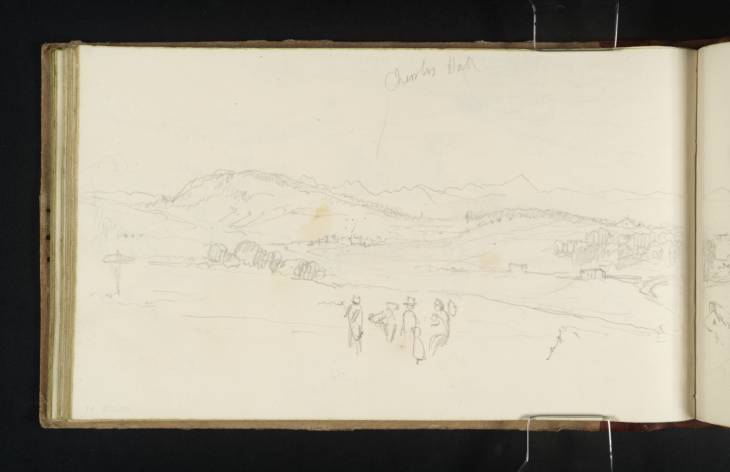Joseph Mallord William Turner Stirling Castle with Bannock Burn from near Borestone to the South 1834
Image 1 of 2
Joseph Mallord William Turner,
Stirling Castle with Bannock Burn from near Borestone to the South
1834
Joseph Mallord William Turner 1775–1851
Folio 47 Verso:
Stirling Castle with Bannock Burn from near Borestone to the South 1834
D26348
Turner Bequest CCLXIX 47a
Turner Bequest CCLXIX 47a
Pencil on off-white wove paper, 113 x 190 mm
Inscribed in pencil by Turner ‘Charles Hall’ top
Inscribed in pencil by Turner ‘Charles Hall’ top
Accepted by the nation as part of the Turner Bequest 1856
References
1909
A.J. Finberg, A Complete Inventory of the Drawings of the Turner Bequest, London 1909, vol.II, p.866, CCLXIX 47a, as ‘Valley, with distant mountains. – “Churton Hall” and Stirling Castle in mid-distance.’.
1936
Henry J. Crawford, Turner’s Sketches and Drawings of Stirling and Neighbourhood with Some Notes on the Artist’s Scottish Tours also a Note on John Ruskin and Stirling, Stirling 1936, p.26.
1979
Andrew Wilton, J.M.W. Turner: His Life and Work, Fribourg 1979, p.433 under no.1122.
1982
Francina Irwin, Andrew Wilton, Gerald Finley and others, Turner in Scotland, exhibition catalogue, Aberdeen Art Gallery and Museum 1982, p.54 under no.72.
1990
Dr David Wallace-Hadrill and Janet Carolan, ‘Turner’s Sketches North of Stirling’, Turner Studies: His Art and Epoch 1775 – 1851, Vol.10 No.1, Summer 1990, p.12.
1990
Dr David Wallace-Hadrill and Janet Carolan, ‘Turner North of Stirling in 1831; a checklist (2)’, Turner Studies: His Art and Epoch 1775–1851, Vol.10 No.2, Winter 1990, p.32 ill.53 in black and white.
Henry Crawford suggested that this sketch was made from the south of Stirling ‘from [the] Bannockburn direction’, although, curiously, he doubted that folios 47 verso and 48 (D26349) were one continuous sketch.1 Not only do the two pages in fact match up very well, but together they provide a composition that is consistent with a view towards Stirling Castle from around Borestone to the south. Turner seems to have travelled to the village of St Ninians and then onto nearby Borestone in order to see the battlefield of Bannockburn (folio 46 verso; D26346), and this sketch probably shows the burn itself, winding its way across the foreground and between Gillies Hill and Castle Hill at the centre of the current page. Stirling Castle can be seen to the right in the continuation of this sketch on folio 48. In the distance on the present page are the rather triangular peak of Ben Vorlich and the double peak of Ben Ledi. The same view is depicted in one of the sketches on folio 47 (D26347).
In the foreground are a group of four of five men, who are perhaps tourists enjoying the view and the historic setting. Their inclusion as a compositional feature suggests that Turner perhaps envisaged a potential painting of the scene. David Wallace-Hadrill has also picked up on the deliberately composed nature of this sketch, commenting that ‘as Turner moved southward from Stirling he saw the Castle as a single element in the centre of the composition of receding planes, from figures in the foreground to Ben Vorlich twenty miles away.’2 Turner’s inscription at the top of the page, which appears to say ‘Charles Hall’, has baffled commentators including this one.
Andrew Wilton, in his catalogue of Turner’s watercolours, mentioned this sketch in relation to Turner’s watercolour of Stirling circa 1834–5 (Glasgow Museums),3 although he does not claim that it was the basis of the composition, which was in fact based on a page of the Stirling and the West sketchbook: Tate D26460 (Turner Bequest CCLXX 13). It is not surprising, however, that he and other commentators have singled out this sketch as it is one of the artist’s most finished and composed views of Stirling in this sketchbook.4
For a list of sketches made from the south of Stirling see folio 46 verso. For a full list of Turner’s sketches of Stirling in this book, see folio 44 verso (D26342).
Thomas Ardill
October 2010
How to cite
Thomas Ardill, ‘Stirling Castle with Bannock Burn from near Borestone to the South 1834 by Joseph Mallord William Turner’, catalogue entry, October 2010, in David Blayney Brown (ed.), J.M.W. Turner: Sketchbooks, Drawings and Watercolours, Tate Research Publication, December 2012, https://www


